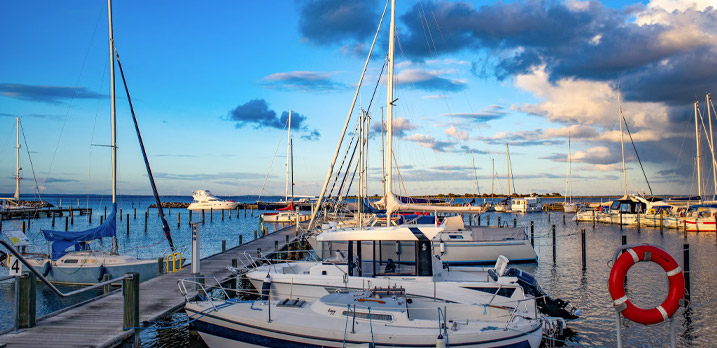
The marina is a place where you can store your boat safely, interact with other boating enthusiasts, and take your boat onto the water conveniently when the time is right. If you want to get the most value out of the marina and remain connected to your community at the same time, it's important to learn the basics of etiquette and safety for this type of location.
Etiquette and Safety Tips for the Marina
As you're about to see, etiquette and safety are sometimes two sides of the same coin. If an action preserves your safety, and preserves the safety of the people around you, it's also polite – and many simple acts of politeness can help you stay safe as well.
With that in mind, these are the most important tips for both safety and etiquette in an average marina:
- Spend time familiarizing yourself with the marina. Whenever exploring a new marina, spend time familiarizing yourself with your surroundings. The better you understand the layout, and the more familiar you are with this territory, the less likely you'll be to encounter an accident or break a rule.
- Review and follow all rules and regulations. In line with this, you'll need to spend some time reviewing the rules and regulations of the marina. Every marina operates a bit differently, so don't assume that you understand all the rules just because you've been to a different marina before. There are some commonsense things you can expect to be rules just about everywhere, but it's still valuable to know what these specific restrictions are.
- Keep your lifejacket on. Your lifejacket is an indispensable piece of safety equipment, and something you should wear at all times on your boat. Many people are tempted to remove a lifejacket upon entering the marina, viewing this area as a location of safety. But while it may be safer than the open water, it still carries some hazards; keep your lifejacket on, and encourage your passengers to do the same, to maximise your safety.
- Be mindful of wet surfaces. Marinas can have wet and slippery surfaces, increasing the risk of a fall. And because this is an expected condition, you may not always see cautionary signage indicating this. Be mindful of where you step and walk with extra caution in wet areas.
- Always respect no wake zones. No wake zones exist to preserve the safety of boaters and pedestrians alike. Even if you don't see anyone else around, you need to respect them. Additionally, it's a good idea to maintain low speeds to reduce noise and disturbances for all the people around you.
- Watch out for pedestrians (and other boats). Keep an eye out for pedestrians and other boats as you travel throughout the marina. Sometimes, these other participants can be difficult to see, posing a major safety hazard if you fail to identify them.
- Verify secure mooring. Whenever docking or mooring your boat, verify that the tethering is secure. This will protect your boat, protect the boats in your immediate surroundings, and potentially even protect you and your passengers.
- Inspect electrical equipment before using. If there is a nearby power hookup, always inspect this electrical equipment before using it. Frayed or damaged connections can pose both an electrical hazard and a fire hazard. If the condition of any electrical equipment is in question, immediately discontinue use.
- Don’t swim or allow swimming. It’s generally inadvisable to swim in the marina, even if it isn’t explicitly forbidden. Marinas are frequently trafficked by boats, and even if there aren't any other boaters around, the water may be polluted, crowded, or otherwise harmful.
- Help keep the marina (and your own boat) clean. Do whatever you can to keep the marina clean. Always properly dispose of your garbage and recycling, and if you see any trash, pick it up. Additionally, avoid storing food scraps or other garbage on your vessel, as this can attract rodents and other pests.
- Fuel safely. When fuelling, always engage in best practices for safety. That means preventing spills, avoiding sources of ignition, and properly supervising the fuelling to minimise the chances of an incident.
- Be mindful of lines and wait times. This is more about etiquette than safety but be mindful of lines and wait times. When launching your vessel or fuelling, work as quickly as possible to avoid holding up other people.
- Use your holding tank. If you need to use the head, use your holding tank (and empty it responsibly).
- Keep your gear off the dock. It's tempting to occasionally leave some of your gear on the dock for the sake of convenience, but this is unsafe and inadvisable. It puts your material possessions at risk and presents a tripping hazard to others.
- Respect others’ vessels. Don't board someone else's boat without permission – and do your best to respect the property of others.
- Keep the volume down. Marinas are fun places where you can party and relax with your friends, but you should generally keep the volume down. Not everyone wants to hear your blaring music.
- Get to know your neighbours. Get to know the other people in your marina. Stronger community ties lead to a safer community, and you might make some new friends along the way.
A Better Marina Experience
If you can follow these rules, you can have a safer, much more enjoyable marina experience. With some extra time and experience, you’ll feel more confident in your ability to successfully navigate this area of boat ownership.
Are you interested in taking your boating experiences to the next level? You might need a new vessel to achieve everything you want. Fortunately, there are countless vessels to choose from, from mega yachts to sailboats and for every conceivable budget.
If you’re ready to start your search, start it here! We’ve got almost anything you can imagine.